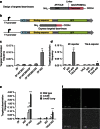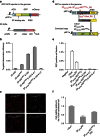Engineering and optimising deaminase fusions for genome editing
- PMID: 27804970
- PMCID: PMC5097136
- DOI: 10.1038/ncomms13330
Engineering and optimising deaminase fusions for genome editing
Erratum in
-
Corrigendum: Engineering and optimising deaminase fusions for genome editing.Nat Commun. 2017 Oct 9;8:16169. doi: 10.1038/ncomms16169. Nat Commun. 2017. PMID: 28991237 Free PMC article.
Abstract
Precise editing is essential for biomedical research and gene therapy. Yet, homology-directed genome modification is limited by the requirements for genomic lesions, homology donors and the endogenous DNA repair machinery. Here we engineered programmable cytidine deaminases and test if we could introduce site-specific cytidine to thymidine transitions in the absence of targeted genomic lesions. Our programmable deaminases effectively convert specific cytidines to thymidines with 13% efficiency in Escherichia coli and 2.5% in human cells. However, off-target deaminations were detected more than 150 bp away from the target site. Moreover, whole genome sequencing revealed that edited bacterial cells did not harbour chromosomal abnormalities but demonstrated elevated global cytidine deamination at deaminase intrinsic binding sites. Therefore programmable deaminases represent a promising genome editing tool in prokaryotes and eukaryotes. Future engineering is required to overcome the processivity and the intrinsic DNA binding affinity of deaminases for safer therapeutic applications.
Conflict of interest statement
L.Y. and G.C. filed the patent related to this manuscript with the application number: US 12/939,505. The remaining authors declare no competing financial interests.
Figures




References
-
- Porteus M. H. Mammalian gene targeting with designed zinc finger nucleases. Mol. Ther. 13, 438–446 (2006). - PubMed
-
- Boch J. et al.. Breaking the code of DNA binding specificity of TAL-type III effectors. Science 326, 1509–1512 (2009). - PubMed
-
- Miller J. C. et al.. A TALE nuclease architecture for efficient genome editing. Nat. Biotechnol. 29, 143–148 (2011). - PubMed
MeSH terms
Substances
Grants and funding
LinkOut - more resources
Full Text Sources
Other Literature Sources

